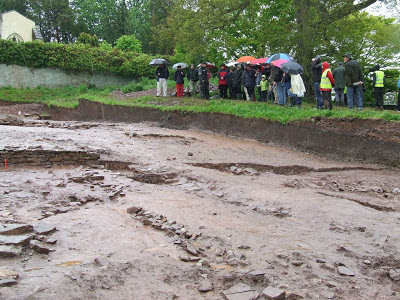What is a Minster?
Berkeley’s Paddock trench has revealed more information suggesting
the site was a part of an Anglo-Saxon minster. But what were minsters and why
are they so important?
 |
| Visitors view a very wet Paddock trench in Week 4 of excavations |
Minsters are the forefathers of common English parishes,
they were the initial religious dwellings in early Anglo-Saxon Christianity. The
first minsters were founded a century after Augustine of Canterbury’s religious
mission to Anglo-Saxon England in 597AD, and they are found in the Royal
charters in the seventh century.
Anglo-Saxon Kings made grants of land to named individuals,
which then found a minster. They were commonly founded by king or royal thegn
(or thane), with the primary purpose to support the king and the thegn in
regular worship of the divine office.
 |
| Thegn seal made of walrus ivory showing religious iconography, c.11th century (Source: British Museum 1881,0404.1) |
The word ‘minster’ actually derives from Old English
‘mynster’, meaning monastery, nunnery, mother church or cathedral. They were
designated by a settlement of clergy living in a communal life, which was
mostly endowed by charter and maintained a daily office of prayer.
Both men and women lived could live in a minster but were
separated by a wall or division due to religious celibacy. However unlike later
monastic life they were a religious community that lived and worked among
ordinary people.
Minsters were original catalysts for and defining marks of
urban growth, they initiated a collection of people living together and
producing items for living, such as food and clothing. This in turn attracted
nonreligious people to live by them, in a way developing the towns we see
today. However in the ninth century all English minsters suffered severely from
Viking invaders, which helped lead Later Saxons to change to a monastery or
collegiate church.
 |
| York Minster (Source / www.yorkminster.org) |
Minsters are now referred to as a large or important church,
such as York Minster. This act of continuing the title of minster was perhaps to
maintain the dignity of these religious buildings as they declined in the
eleventh century.
There are very few records of early minsters left and most
minsters are now parish churches. Archaeological
evidence is also scarce. Inside early compounds, the buildings were mainly of
timber with thatched roofs, as early Anglo-Saxons rarely built with stone. This
indicates why the find at Berkeley is so ground-breaking; it could be a
definitive, rare example of an early Anglo-Saxon religious community building.
It is known from historical records that Medieval Berkeley
was a large port and market town in Gloucestershire. This minster
could show the initial building that housed the community, providing insights
into the developments and change of this small town.
Comments
Post a Comment